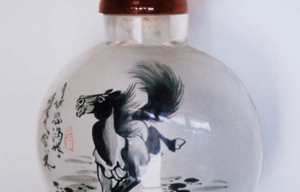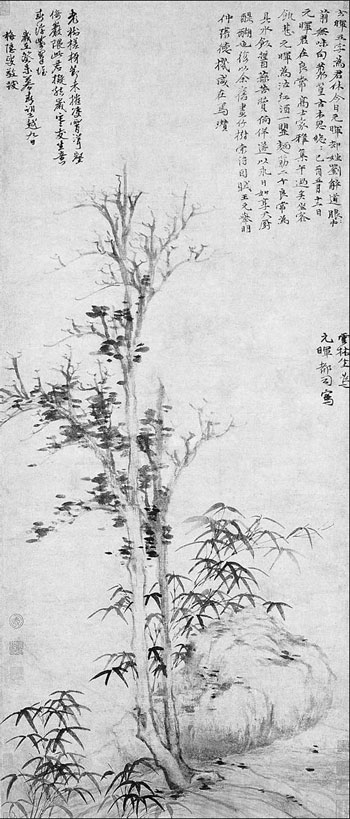Heritage
Purist Perfection
Updated: 2011-09-18 07:19
By Zhang Kun (China Daily)
|
Ni Zan's art drew inspiration from the simplest natural forms, and he avoided putting human images in his paintings, deeming them less than perfect. [Provided to China Daily] |
He became a recluse because he disliked the invaders who had overrun his country. Zhang Kun turns the spotlight on Yuan dynasty painter Ni Zan.
His artistic style drew largely from his eccentric character, although later critics all agreed that his work was luminous with serenity and purity. Ni Zan (倪瓒) lived from 1301 to 1374 and was also known as the "Hermit of the Cloud Forest" or Yunlin Jushi.(云林居士).
His favorite subjects were landscapes with sparse vegetation and a noticeable lack of humans.
"You hardly find images of people in his paintings, except for maybe a few Taoist monks, as he regarded ordinary people as so much less attractive than what he imagined and depicted in his art," notes Lu Li, director of the curatorial department of Nanjing Museum in Jiangsu province.
Nanjing Museum has one rare painting by Ni, a scroll of two old trees and a cluster of bamboo (丛篁古木图轴) that is 102 centimeters long and 43.9 centimeters wide. Its composition is deceptively simple, and it exudes a lonely and aloof air, Lu says. The artist used light ink strokes for the branches and there are minimal leaves on the bamboo.
It is a style that also reflected the political climate of the artist's times. The Han people and their culture were being largely neglected by the Yuan Dynasty (1271-1368) of the ruling Mongols. Many Han intellectuals realized they would never find advancement under the Mongols, and many turned to Taoism, which advocated life away from worldly pursuits.
 |
"Many great landscape paintings were created during that time," Lu says. "Because intellectuals dreamed of moving to the mountains to be hermits. Ni Zan shared that mentality."
Ni was not only obsessed with purity of the soul and mind, he was affected by a fetish for cleanliness. Many anecdotes were passed down about his obsession.
He would send for water from the creek, and then throw it all out because he believed the porter had contaminated it on the way back. And, he would instruct his servants to scrub the trunk of the phoenix tree growing in his courtyard repeatedly, so much so that the tree sickened.
Another famous anecdote told of how he had sold his property to help a friend, but inadvertently broke the law by not following proper procedures. Ni sought refuge among the reeds on the islands of Taihu, hoping to hide from the officials out to arrest him. They had no problems finding him, however, because they simply followed their noses.
The rare and expensive incense he used to fumigate his surroundings gave him away.
Ni painted mostly with ink because he felt the color pigments were not pure enough. He was so obsessed with the clarity of his paintings that he was reluctant even to place his personal seal on them. His painting style and attitude deeply influenced later artists and intellectuals and he is recognized as one of the Great Four artists of the Yuan Dynasty.
There are some who consider him an even better painter than Huang Gongwang, whose work Dwellings in the Fuchun Mountains is one of the best examples of that age.
The other respected Yuan artists are Wu Zhen (吴镇) and Wang Meng (王蒙).
Today, most of Ni's surviving works are at the Palace Museum in Taipei, with a few in museums in Jiangsu province. The paintings in Jiangsu were donated by Pang Laichen, according to Nanjing Museum's Lu.
Pang was from a wealthy family in Zhejiang and spent most of his fortune collecting antique paintings. He was once recognized as "the world's largest collector of Chinese paintings and calligraphy." Pang died in Shanghai in 1949 and most of his collection was donated to museums in Shanghai, Beijing, Nanjing and Suzhou.
The family did not get any compensation for its valuable contribution then, and it was not until the 1980s that Pang's children were rewarded for their protection of China's cultural heritage and given an apartment in Suzhou where they now lived.
"People who donated to China's museums used to get nothing but a certificate," according to Shen Jialu, a writer and antique collector based in Shanghai. In the 1980s, Ma Cheng-yuan, the former director of the Shanghai Museum, applied for government funding to buy an air-conditioner for each of the important contributors who donated rare antiques to the museum, as recognition for their gifts.
You can contact the writer at zhangkun@chinadaily.com.cn.
E-paper

The snuff of dreams
Chinese collectors have discovered the value of beautiful bottles
Perils in relying on building boom
Fast forward to digital age
Bonds that tie China. UK
Specials

Let them eat cake
Cambridge University graduate develops thriving business selling cupcakes

A case is laid to rest
In 1937, a young woman'S body was found in beijing. paul french went searching for her killer

Banking on change
Leading economist says china must transform its growth model soon

